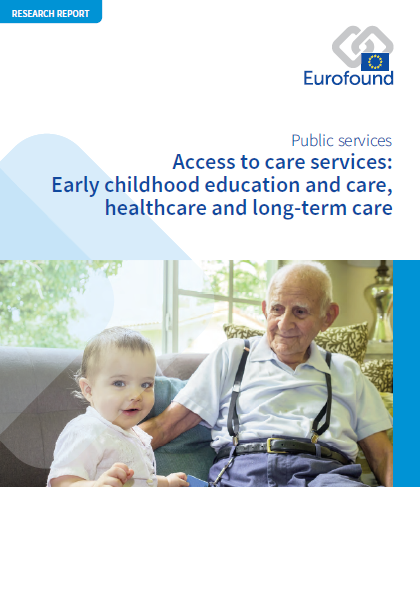
Euroopa sotsiaalõiguste sambas tõstetakse esile kvaliteetsetele hooldusteenustele juurdepääsu õigust. See aruanne keskendub kolme liiki hooldusteenustele: alusharidus ja lapsehoid, tervishoid ja pikaajaline hooldus. Juurdepääs neile teenustele on aidanud vähendada ebavõrdsust kogu elutsükli vältel ning saavutada naiste ja puuetega inimeste võrdõiguslikkus. Tuginedes Eurofoundi korrespondentide võrgustiku andmetele ja Eurofoundi uuringutele, annab aruanne ülevaate hetkeolukorrast ELi liikmesriikides, Norras ja Ühendkuningriigis, tuues välja hooldusteenuste kasutuselevõtu tõkked ja elanikkonnarühmade erinevad juurdepääsuprobleemid. Aruanne keskendub eriti kolmele valdkonnale, mis aitavad teenustele juurdepääsu parandada: puuete või hariduslike erivajadustega laste alusharidus ja lapsehoid, e-tervishoid ja asendushooldus.
Key findings
Probleemid, mitte ainult rahuldamata vajadused. Lõppkokkuvõttes võivad inimeste hooldusvajadused saada rahuldatud, kuid nad kogevad protsessi vältel raskusi.
Taskukohasus on peamine tõke, kuid hooldusteenuste maksumuse vähendamine ei lahenda seda probleemi, kui ei võeta laiemalt arvesse leibkonna sissetulekut ja kulutusi.
Juurdepääsuõiguse tõhusaks jõustamiseks on oluline keskenduda eri tahkudele kogu protsessi vältel, alates vajaduste tuvastamisest kuni nende rahuldamiseni ning leibkonna, organisatsiooni ja ühiskonna tasandi tegurite käsitlemiseni.
Paljud inimesed ei kasuta alushariduse ja lapsehoiu teenust ega pikaajalise hoolduse teenust, sest nad kasutavad mitteametlikke hooldusteenuseid, kuid nad võiksid neid teenuseid kasutada, kui need oleksid taskukohasemad, paremini kohandatud või kvaliteetsemad.
Et suurendada vastupidavust majandusšokkide suhtes, peaks juurdepääs tervishoiuteenustele sõltuma vähem sissetulekust ja tööhõivest.
Table 1: Number of respite care recipients, selected countries
Figure 1: ECEC, healthcare and long-term care in the European Pillar of Social Rights
Figure 2: General framework for access to care services
Figure 3: Main reasons for not using professional ECEC, EU27 and the UK, 2018 (%)
Figure 4: Main reasons for not meeting needs for formal ECEC services, EU27 and the UK, 2016 (%)
Figure 5: Level of difficulty in affording ECEC services by income group, EU27 and the UK, 2016 (%)
Figure 6: Proportion of people reporting unmet medical needs and main reason, EU27 and the UK, 2018 (%)
Figure 7: Main reason for unmet medical needs, EU27 and the UK, 2018 (%)
Figure 8: Financial barriers to accessing healthcare: ‘unmet needs’ versus ‘access difficulties’, EU27 and the UK, 2016 (%)
Figure 9a: Unmet needs due to any reason, by employment status, EU27 and the UK, 2010–2018 (%)
Figure 9b: Unmet needs due to affordability, by employment status, EU27 and the UK, 2010–2018 (%)
Figure 10: Proportion of people anticipating difficulties paying for particular types of healthcare, by income quartile and employment status, EU27 and the UK, 2016 (%)
Figure 11: Proportion of people with severe long-standing limitations due to health problems, by age group, EU27 and the UK, 2018 (%)
Figure 12: Use of formal long-term care in previous 12 months by respondent or someone close to them, country groupings, 2016 (%)
Figure 13: Proportion of people aged 65+ with some or severe activity limitations who lack assistance, 2014 (%)
Figure 14: Professional home care: main reason for unmet needs, 2016 (%)
Figure 15: Proportion of people using professional home care services by hours used, EU27 and the UK, 2016 (%)
- Number of pages
-
88
- Reference nº
-
EF20015
- ISBN
-
978-92-897-2108-0
- Catalogue nº
-
TJ-02-20-624-EN-N
- DOI
-
10.2806/7624
- Permalink
Cite this publication
Eurofound (2020), Access to care services: Early childhood education and care, healthcare and long-term care, Publications Office of the European Union, Luxembourg.